Nach Waxman's Brisket of beef is everything you want brisket to be: tender, deeply flavorful and moist with rich gravy that tastes like the best onion soup. Waxman's ingenious recipe calls for cooking the brisket on top of a mountain of onions with no water, and slicing the meat halfway through cooking.

This recipe is famous among brisket lovers and one of the most (if not the most) popular brisket recipe on the web, and for good reason. It's a relatively simple, no fuss recipe and the result is outstanding brisket.
I've been cooking Nach Waxman's brisket for years. I always make it for Passover and Hanukkah. It's long overdue that I share this incredible brisket recipe here with you!
THE BEST BRISKET RECIPE!
There's so much to love about Nach Waxman's Brisket recipe.
- It is moist and tender beyond anything I've ever experienced with brisket, and I have been making brisket for a long time.
- The flavors are rich and delicious, with lots of caramelized onions that are out of this world!
- The recipe is simple, with just a handful of ingredients
- It's a no-fail recipe.
WHO IS NACH WAXMAN?
So who is this man with the famous brisket? Interestingly, he's not a chef. Nach Waxman is the owner of a highly esteemed New York City Cookbook store called Kitchen Arts and Letters. And he's an expert on cookbooks and food history.
With regard to his legendary brisket recipe, Waxman gives creds to his mother for the huge amount of onions used and to his mother-in-law for the pre-slicing technique.
Nach Waxman's Brisket Recipe first appeared in 1989 in The New Basics Cookbook, which has become one of the best selling cookbooks in the world. Also one of my personal favorites. It's by Julee Rosso and Sheila Lukens, who authored the famous Silver Palate Cookbook.
Now let's talk about brisket. What is it? Why is it so challenging to cook? Why is it so delicious? Here's the scoop.
WHAT IS BRISKET?
Brisket is a tough muscular cut of meat that comes from the breast of the beef. It's not inherently tender and if not prepared correctly, brisket can end up dried out and tough, which is a very unhappy outcome, especially when you've worked long and hard to cook it for a special occasion.
But when brisket is cooked well, there's nothing more tender or delicious. Keep reading and I'll share all of my favorite brisket cooking tips along with Nach Waxman's ingenious brisket recipe.
WHICH CUT OF BRISKET IS BEST?
When you go to the grocery store or butcher shop to buy brisket, you'll have a choice of first cut or second cut. Either cut will work well in this recipe, yielding delicious tender brisket. I do, however, have a preference for first cut brisket, and here's why.
- The first cut, often called the flat cut, is the leaner of the two and is fairly uniform in thickness. When you cut it, you'll get nice even slices.
- The second cut, also called the point or the deckle, is fairly fatty and uneven in thickness, making it harder to slice evenly and more prone to falling apart.
- Normally a leaner cut of meat is more likely to dry out after a long braise, but that is not the case for this recipe because the meat is sliced halfway through cooking and then submerged in the fatty juices for the rest of the cooking time, which results in super tender moist brisket.
TOP TIPS FOR COOKING THE BEST BRISKET
- TIP #1 - BROWN THE BRISKET BEFORE BRAISING. Flouring and browning the brisket before braising caramelizes the surface of the meat which brings rich flavor and color to the finished dish. Note that if you're making this for Passover, you'll want to use matzo meal in place of flour.
- Brown it all over. A 6-pound brisket can be a bit unwieldy. As you see in my photos below, I had to wrestle with this rather large brisket to get it browned on all sides. Don't worry if your brisket seems too big for the pot. Move it around. Push it down into the oil. Flip it over. Get it nice and brown over most of the surfaces. And about fitting it in the pot, I've had many a brisket that I thought would never squeeze into my Dutch oven and somehow they've all ended up fitting in. Hopefully yours will too!

- Once your brisket is seared, transfer it to a plate and add the onions to the pot. This recipe calls for eight onions. That's a lot. No worries if you have a mountain of onion slices coming up out of the pot. They will shrink down and fit perfectly. It's the onions that create most of the tasty braising liquid in this recipe.

- When the onions are golden brown and have cooked down a bit, place the brisket on top of them. Now comes the step that I love the most: using a butter knife, frost the brisket with tomato paste as if you are frosting a cake.
- Place a carrot and a few garlic cloves around the brisket. Cover the pot and set it into a 375ºF oven for 1 ½ hours.
- If you're wondering whether I forgot to say add the water, I didn't. This recipe calls for zero water. You will be amazed how much liquid is produced by the onions, carrot and meat juices.
- TIP #2 - SLICE THE BRISKET HALFWAY THROUGH COOKING. This is Nach Waxman's stroke of genius - to slice the brisket when it's half cooked, reassemble it in the pot as it was before, on top of the onions, and cook for two more hours. This step has many benefits:
- Firstly, half-cooked brisket is the perfect firmness for slicing - not too hard and not too soft.
- Secondly, the sliced meat is returned to the pot and immersed in the fatty braising liquid for the second half of cooking. This acts as a self-baster, with every slice of meat in contact with the braising liquid, resulting in super tender moist meat.
- Thirdly, when you're ready to serve the brisket, it's already sliced. I love this so much!
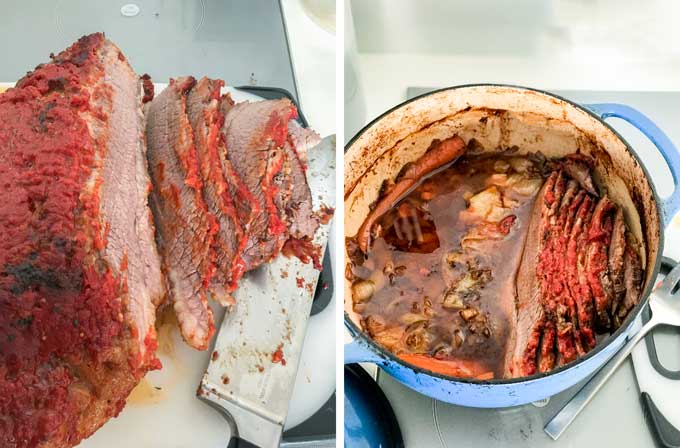
- TIP #3 - SLICE BRISKET AGAINST THE GRAIN FOR MAXIMUM TENDERNESS
- The way you slice meat matters a lot. Meat has a grain which is defined by the muscle fibers that run in one direction. You can see them if you look closely at a piece of meat.
- These fibers are tough. If you cut along the grain, leaving the fibers in tact, you'll have to chew through those tough stringy fibers.
- If you slice the meat against, or perpendicular to those fibers, you'll literally break them down with your knife, making your meat nice and tender.
- Below you can see I've cut against, or across the grain of this brisket. Each of those little shapes you see in the meat are cross-sections of fibers that have been cut.
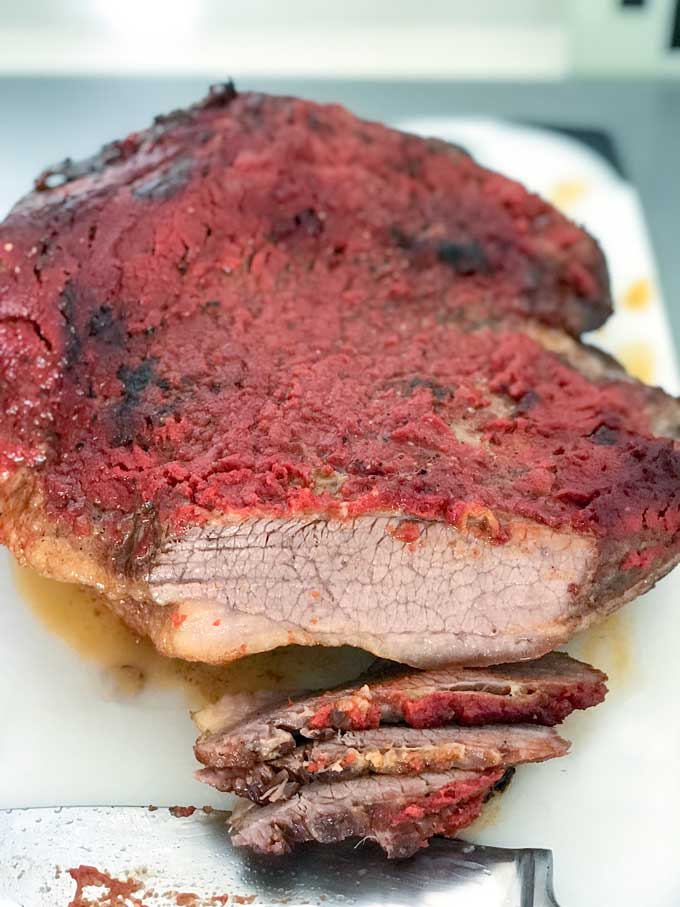
HOW TO SERVE REHEAT AND FREEZE BRISKET
- Brisket can be kept in the fridge for up to three days. The flavors only get better over time. Another benefit of chilling the brisket is that the fat rises to the top and hardens and can be easily removed.
- Brisket freezes well. When I'm cooking brisket for Passover I often make two briskets weeks in advance and freeze them. Freeze Brisket in an airtight container with all the fat and juices. Defrost in the fridge and reheat.
- Reheat chilled brisket in a heavy covered pot, in a 325ºF oven for 40 minutes to an hour.
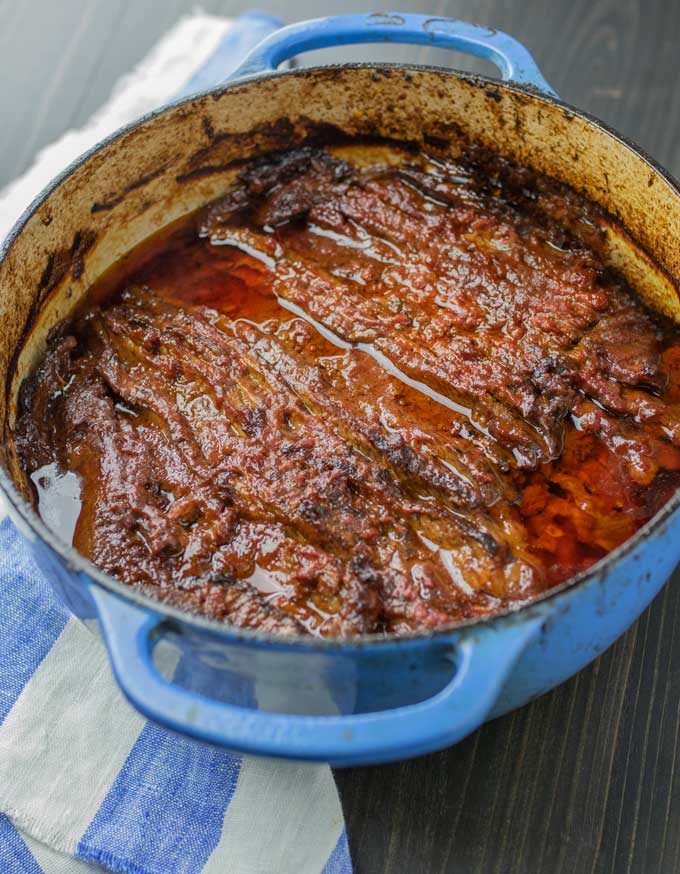
Serve brisket warm from the oven. Arrange the sliced brisket on a platter and pour some gravy over the top or serve it on the side.
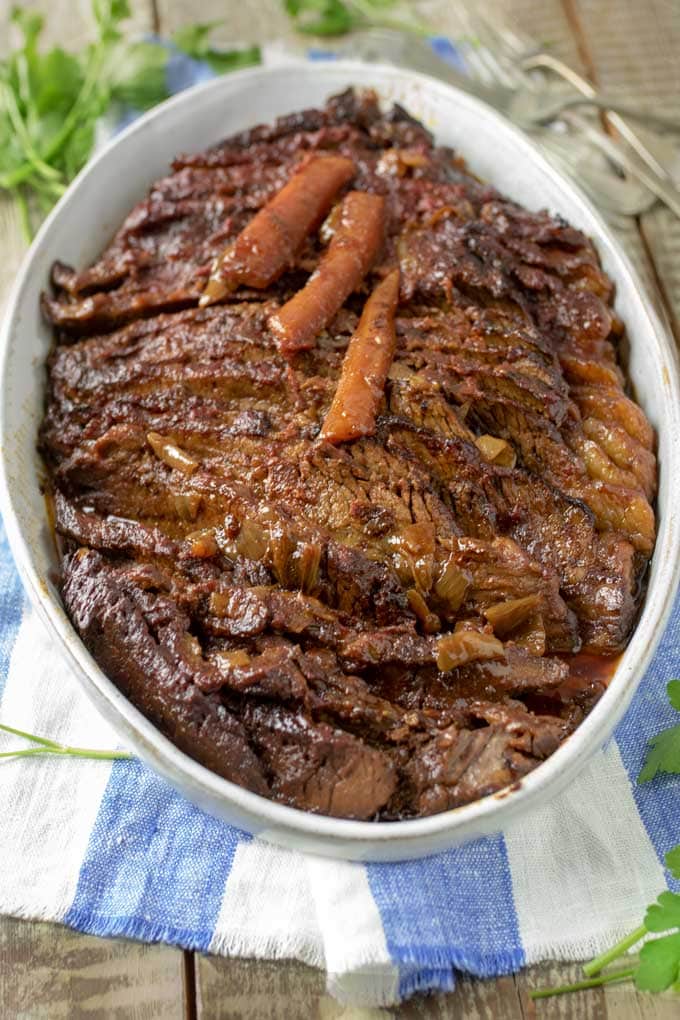
Recipe
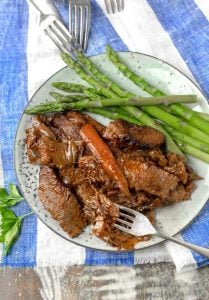
Nach Waxman's Brisket
- Total Time: 4 hours
- Yield: 10-12 servings 1x
Description
Adapted from Nach Waxman's recipe in The New Basics Cookbook.
The brisket, coated with tomato paste and cooked with lots of onions, is exceptionally tender and flavorful, and the recipe is surprisingly easy.
Ingredients
- 1 first-cut brisket of beef, 5-6 pounds, trimmed with a thin layer of fat remaining on one side*
- 2 teaspoons kosher salt plus more, to taste
- Fresh ground black pepper, to taste
- 3-4 tablespoons all-purpose flour or matzo meal**
- 3 tablespoons high smoke point cooking oil such as canola or rapeseed
- 8 medium yellow onions
- 4-5 tablespoons of tomato paste, or as much as you need to coat the brisket (from a 6-ounce can)
- 4 garlic cloves, peeled and thickly sliced
- 1 carrot, peeled and halved lengthwise
Instructions
Equipment: A large heavy pot or Dutch oven with a lid.
- Preheat oven to 375ºF. Peel the onions and thickly slice them crosswise (not through the root). Put onion slices into a big bowl and separate them into rings. Set aside.
- Season the brisket on both sides with salt and pepper. Dust with flour on both sides.
- Heat oil in the pot over medium heat. Brown the brisket all over. If the brisket is larger than the pot, you'll need to work with it, pushing it around and down into the oil and flipping it over and moving it, until you've got a nice brown color and crusty bits over most of the meat. Transfer the brisket to a platter and add the onions to the pot.
- Turn the heat up a bit and cook the onions, stirring often with a wooden spoon and scraping up the browned bits on the bottom of the pot, until the onions are golden brown but not yet caramelized, about 15 minutes.
- Turn off the heat. Place the brisket, fat side down, on top of the onions. Using a small butter knife or something similar, coat the the top and sides of the brisket with tomato paste, as if you were frosting a cake. [I sometimes use the whole can if my brisket is very large] Sprinkle with more salt and pepper, to taste.
- Tuck the carrot halves and garlic around the outside of the meat. Cover the pot and cook for 1 ½ hours.
- Pull the pot out of the oven and turn the oven down to 325ºF. Transfer the brisket to a cutting board. Using a very sharp knife, cut the meat across the grain, into thin slices. (see explanation in post about cutting across the grain) Carefully return the slices to the pot as if you are reassembling the brisket. Place your knife between each slice to make sure some of the liquid gets between all the slices. Slightly tilt the slices to one side to ensure they stay down in the liquid. Cover the pot and return it to the oven for another two hours, until fork tender. Check the pot once or twice during cooking. If it looks dry add 2-3 teaspoons of water.
- Brisket is ready to serve or it can be refrigerated for up to three days. Flavors only get better over time.
- This brisket freezes well.***
Notes
* First cut brisket is sometime called flat cut brisket. It's relatively lean but has a layer of fat on one side. That fat should be left on the meat as will help keep the brisket moist and tender as it braises.
** If you're cooking Brisket for Passover, regular flour is not permitted. Substitute Matzo Meal.
***Freeze the brisket with onions and juices in an airtight container for up to 3 months. Defrost in the fridge overnight and reheat in a a heavy covered pot in a 325º oven for 40 minutes to an hour.
Nutrition Information: The information shown is an estimate provided by an online nutrition calculator and is not a substitute for a the advice of a professional nutritionist.
- Prep Time: 20 mins
- Cook Time: 3 hours 40 minutes
- Category: Dinner
- Method: Oven
- Cuisine: Out of this World









Melinda
Can this be made in a roasting pan? I don't have a Dutch oven big enough. Also does the gravy freeze well?
Lisa Goldfinger
You can make this in a roasting pan if you cover it very tightly with a double layer of heavy foil. I think you'll have to use a large skillet for browning the meat and cooking the onions. Then transfer everything to the roasting pan, cover tightly and braise. This whole dish freezes well. I suggest you freeze everything together. I hope you enjoy!
Beth
I’ve made this recipe often and slicing it partway through is not just for convenience but in order to cook each slice in the braising liquid. It’s really better that way.
This does also work with a chuck roast, it’s just not as succulent as a brisket.
John
What would the cooking time be for a 12lb brisket?
Lisa Goldfinger
Do the initial 1-1/2 hours at 375 and then I'm guessing you'll need 4 hours at 325 but check it for tenderness after 3-1/2 hours.
Marie
I have a smaller brisket, about 2.5 lbs. Is the cooking g time the same or should I shorten it?
Lisa Goldfinger
I’ve made this recipe with a smaller brisket - about the same size as yours - and cooked it the same amount of time. It came out great.
Tina
Could this be done in a slow cooker? I would love to make this during the summer but don’t want to heat up the whole house!
Lisa Goldfinger
Hi Tina - that's a great question. I'm sure this recipe would work well in a slow cooker. Here are my thoughts: 1 - You probably can only fit a 3-4 pound brisket in a slow cooker. 2 - You'll still need to brown the onions and brisket in a skillet or Dutch oven before putting them into the crockpot. 3. I'm guessing you'll need to cook it either on high for 4.5-5 hours or on low for 8-10 hours. If you make this in a slow cooker, I would love to hear back from you about the details of how you made it and how it turned out!
Carrie
Would not slicing it after 1 1/2 hour and just let it cook till soft affect the way the brisket comes out?
Lisa Goldfinger
You can absolutely cook it all the way through and it will be great! The only reason for slicing it half way through is to make slicing easier. Also, it's nice to be able to take the pot out of the oven ready to serve.
Eileen Rosenberg
Was planning on making this for Passover. Questions- Can I use a lot of carrots? Can I add a can of whole tomatoes? Can I add brown sugar?
This was all part of the way I’ve always made my brisket.
Thanks for response!!!
Lisa Goldfinger
Good questions Eileen, and the answer is yes, you can definitely use lots of carrots and brown sugar and a whole can of tomatoes. I've used this same technique with different combinations of ingredients and it always works beautifully. The one thing I would not do is add additional liquid. You don't want the brisket to boil - it braises beautifully in the liquid released by the onions. Wishing you a Happy Passover!
Mar
This is the best nofault brisket recipe I make for the holidays and always have to look it up. So glad I landed here and found your comforting words about wrestling the brisket into the pot! It always stressed me but you’re right — somehow it always fits and works out.
Steve Reid
Ok all done now for the two hours of sit and enjoy a glass of wine .
I seem to have plenty of sauce/gravy so I might use some and turn the rest into a soup with,maybe, the leftover brisket.
Cheers Lisa ????
Phyllis Luberg
This brisket was the best ever!
We enjoyed it for Passover and enjoyed it just as much the next day! So tasty!!!!